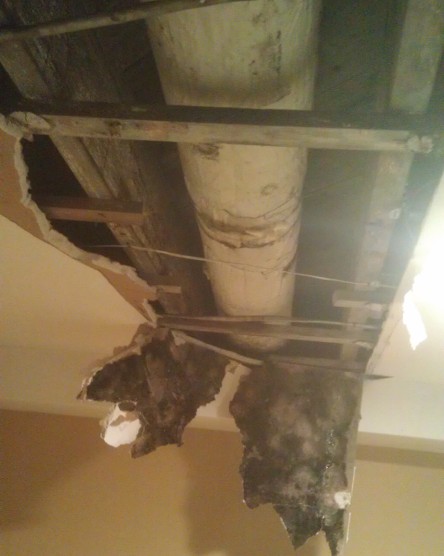Find a Mold Specialist Now
Click or Call, Toll-Free 24/7
Myrothecium verrucaria
Found all around the world, Myrothecium verrucaria is a green or black mold with white flaky edges. It is often found on plants and in fact, it is so harmful to many plants that the U.S. Department of Agriculture has used it to control invasive weeds like kudzu.
It is not only found outdoors or on plants, though. It can be found indoors on building materials that contain a lot of cellulose, such as paper, drywall, and many textiles. The mold breaks down the cellulose in those materials rapidly, which can do quite a lot of damage to your home in a very short period of time.

Damage to Your Home from Myrothecium Verrucaria
Because of the way it breaks down cellulose, this mold can destroy materials like drywall and ceilings in no time. Your house can literally begin to collapse around you. This mold also spreads easily from one area to another, so it can quickly affect your entire home. For these reasons, and to reduce the risk of contracting a mold-related illness, it is very important to address any mold in your home as soon as you can.
Health Problems Related to Myrothecium Verrucaria Exposure
Like some other strains of mold, according to Mycota, an online database of mold species compiled by researchers and other experts in the field, this one produces toxic substances called mycotoxins. These mycotoxins can make you sick.
In addition, mold reproduces by producing hundreds of thousands of mold spores, microscopic particles that are easily inhaled. Inhalation of mold spores can also make you sick, leading to respiratory infections, allergy symptoms, and asthma attacks.
Some people are known to be at greater risk for mold-related health problems, including those with respiratory disorders such as asthma, those with compromised immune systems, the very young, and the elderly. Those are not the only people that can get sick from exposure to mold, though. Exposure to mold, especially prolonged exposure, is not safe for anyone and illness can result. Even your pets can get sick from mold in your home.
If you think you are experiencing symptoms of mold-related illness, see your general practitioner or internist. You can learn more about common symptoms of mold-related illness here. Make sure you let your doctor know you’ve been exposed to mold.
Treatment will depend on your symptoms but may include antifungal medications, antibiotics, decongestants, antihistamines, and/or corticosteroids to reduce allergy symptoms. You may be referred to a specialist such as an allergist or infectious disease specialist.
Mold Removal
Because Myrothecium verrucaria causes so much damage to your home, the mold needs to be removed as soon as possible and the job needs to be done properly so that no mold remains. If you miss even a little mold, it could grow and spread and soon you’ll have another serious mold problem on your hands.
Safety precautions must be taken when removing mold from the home because the very process of cleaning up mold will expose you to mold spores and mycotoxins that can make you sick. The fact that this mold causes household materials to break down and crumble so easily increases the risk of inhaling harmful particles that can cause illness. Homeowners and professionals alike are advised to wear protective gear, including an N-95 or N-99 respirator mask, disposable gloves, a hair cover and shoe covers, when removing mold. You can learn more about safety equipment for removing mold here.
The U.S. Environmental Protection Agency (EPA) recommends consulting your doctor before attempting to clean up mold on your own if you have mold-related health problems or medical conditions that might be made worse by exposure to mold, such as asthma or disorders affecting your immune system. Your physician may recommend hiring a mold removal professional to prevent further exposure to mold and to make sure the job is done correctly.
Whether you wish to hire a professional for the job or plan to do the work yourself, we recommend scheduling a free consultation with a mold removal professional. An experienced professional will visit your home, inspect for mold, explain the mold removal work that needs to be done, and answer any questions that you have. He or she can advise you about the safety precautions that need to be taken when removing mold. There is no cost and no obligation on your part. You can find qualified mold removal professionals in your area by following the link provided.
Return From Myrothecium Verrucaria To Our Main Mold Types Page
Privacy Policy Terms and Conditions Accessibility Do Not Sell My Information Disclaimer Contact Us




